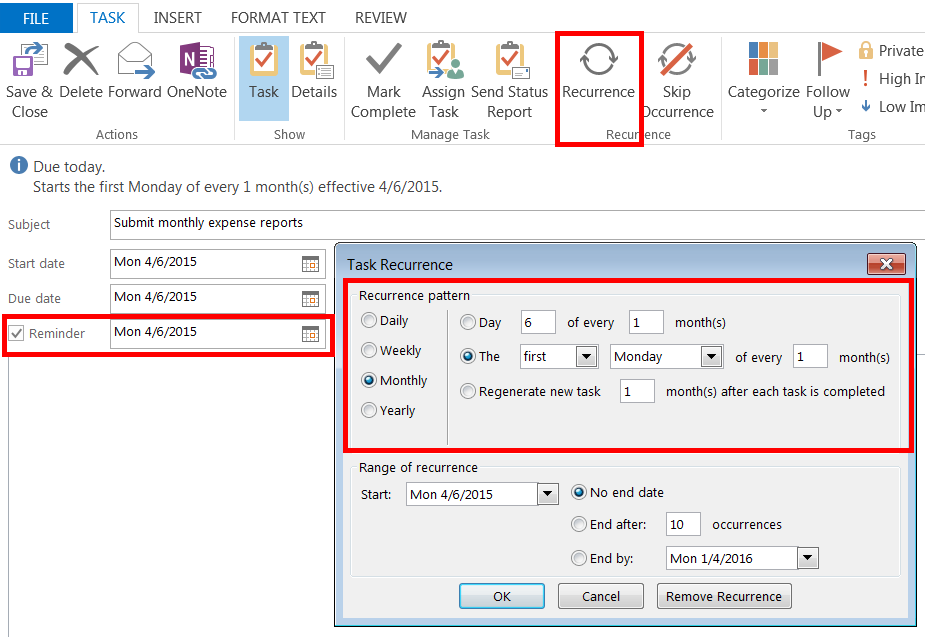

For example, if your recipient’s deadline is 4:30 p.m. The good news is it can be completely independent of the one you set for your recipient – different day, time, and action. While you’re here, you can also set a reminder for yourself to follow up on email you send. to give your recipient(s) one last chance to make the deadline. For example, if on Tuesday you send out a court docket for staff to review no later than Wednesday noon, you can set a reminder for Wednesday at 11:30 a.m. The reminder will default to today’s date, but you can re-set it to whenever you like. Here’s where you can set a reminder for your recipient by checking the Flag for Recipients checkbox. In either version, you end up with a dialog box that looks like this: Weirdly, in version 2010, Microsoft didn’t see the need to make this function as clear, so you have to click on Add Reminder to get to the right dialog box to add the recipient’s flag: In Outlook 2007, the drop-down looks like this: This is where you can set a reminder to pop up for your recipient, prompting him/her to respond to your email. If you look a little more closely on the Message tab (the one showing by default), you’ll see a drop-down called Follow Up. When you open up a New Message window to start composing, it’ll look something like this: Reminding your recipients to respondįirst, we want to make sure your recipients don’t let your request get shoved down in their Inbox. This flagging requests people make of you is all well and good, but what about all that stuff you’re asking for? That deserves a little attention, right?


wav extension), or you can turn the reminder sound off altogether if all you want is a silent pop-up window. You can customize the reminder sound by clicking on the speaker button and browsing to a different sound file (usually one with a.That may be helpful if you want to, say, group all your phone calls or reading assignments together. In addition to the action Follow Up, you can also choose from Call, Do Not Forward, For Your Information, Forward, No Response Necessary, Read, Reply, Reply to All, and Review.This can affect when the flagged email shows up in your Tasks/To Do list or on your Calendar (depending on your settings). In addition to being able to choose the date and time your reminder pops up, you can also set Start and Due Dates independently (they default to the same date).

If you click Add a Reminder on the menu above, you can have Outlook pop up a reminder window (just like the one you see for calendar appointments) at the time and date you choose: That’s a quick visual way to see what deadlines are urgent versus ones that are down the road a bit.) (Notice that the closer the deadline, the redder the flag is. Custom (allows you to set up whatever date you want).No date (follow up whenever – no deadline).Next week (basically, the following Monday).If you right-click that flag, however, you get lots more choices: See that flag that’s circled on the right? If you left-click on that flag with your mouse, Outlook will (by default) set the flag to the action Follow Up with a due date of today. Take a look at the message in your Inbox: Say your boss sends you an email on Tuesday that says, “Do a search for any judgments on file for XYZ Corporation for Friday’s real estate closing.” You’re busy with another project, but you want to make sure you get your search results delivered in time. Let’s start with an easy one: flagging an email in your Inbox for follow-up or other action. Here’s just about the simplest way for a busy person like you to manage all this: flagging incoming and outgoing emails for follow-up. Make doubly sure you don’t drop the ball on anything anyone’s asked you for, either.Make sure your request doesn’t drift off the other person’s radar and.Make sure you don’t forget what you’ve requested from others.If you’ve got requests and responses flying back and forth via Outlook email, you need to: So, whaddya do to keep track of all those little requests (both the ones you send and the ones you receive)? After all, as easy as it is to send someone an email, it’s just that easy for both sender and receiver to forget it’s there. In the “asking them to do something for you” department, though, things can get a little hairy. Email’s great, isn’t it? You can just type up a quick little message to someone to send them some information or answer a question or ask them to do something for you.


 0 kommentar(er)
0 kommentar(er)
